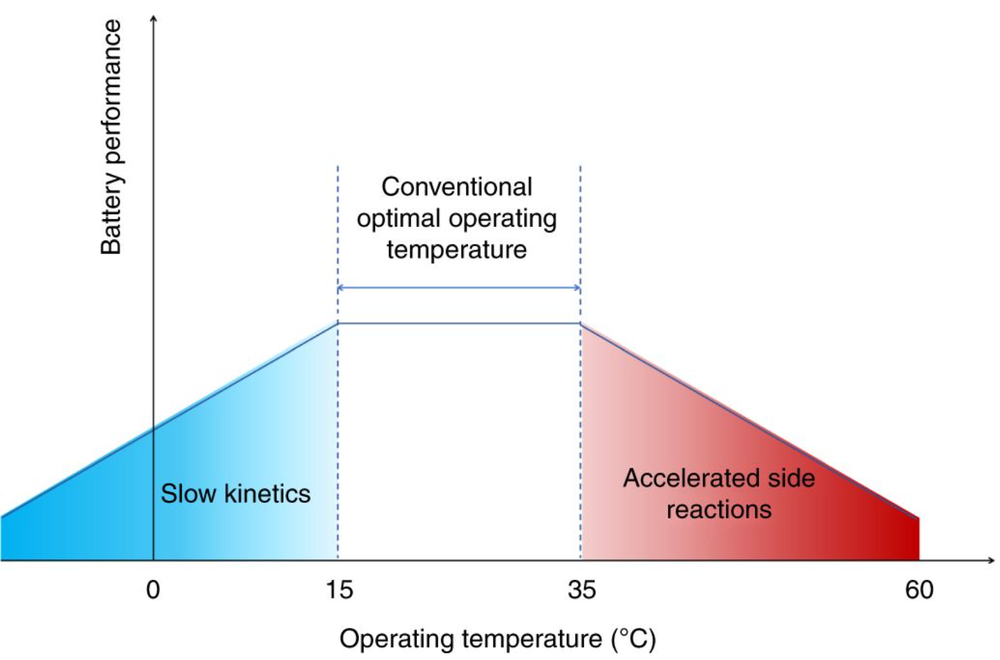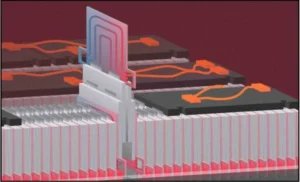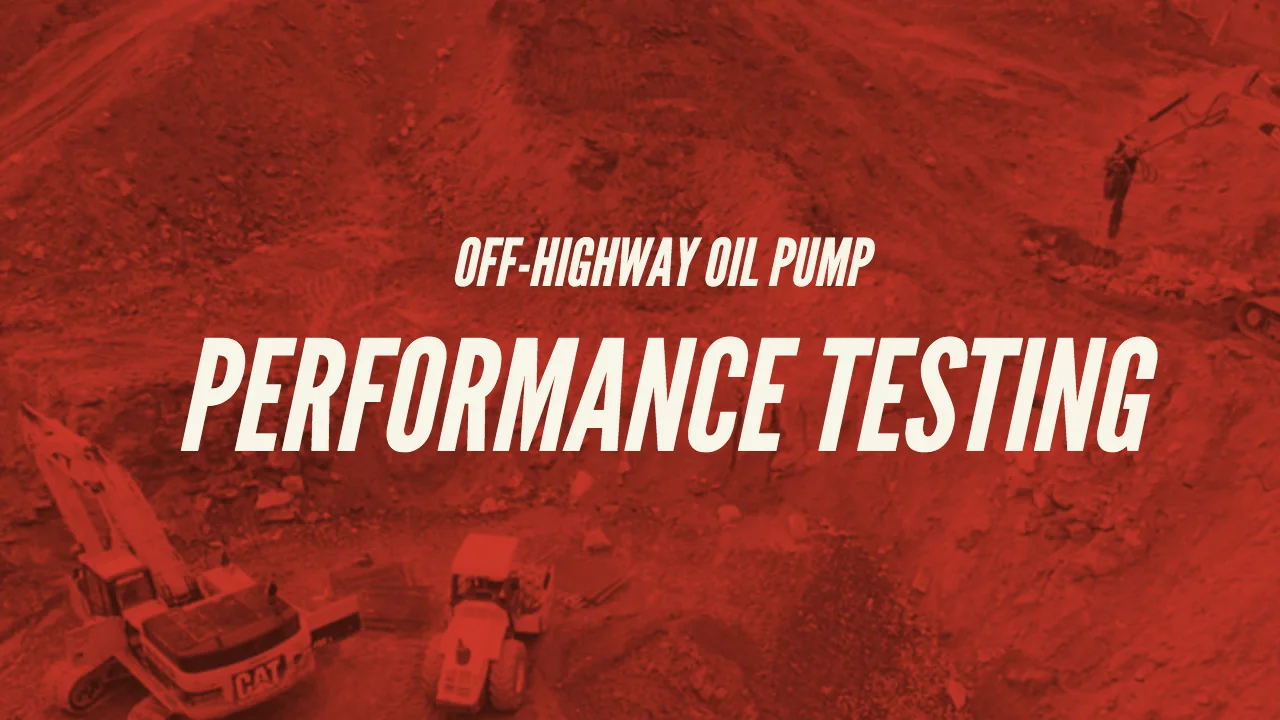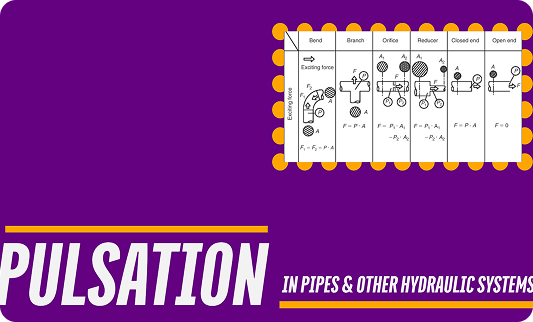A pain point of modern battery-powered vehicles is battery charging convenience. Ideally, charging times would be comparable to refueling an internal combustion engine (ICE) vehicle, but the reality of current EVs is that charging the batteries to achieve a similar range can take hours.
Increasing the Allowable Charging Speeds of EV Batteries is Desirable
The technical challenges of bringing the required energy “along the electron fueling chain” (from the electrical power grid into the vehicle battery) in a matter of minutes are significant. For one, infrastructure upgrades to the power grid will be required to avoid local overloads due to the demand from charging stations. This is being developed by regional power supply companies. Charging station technology also needs to provide high amounts of energy at high speed. DC fast-charging stations for passenger cars have now reached power capabilities up to 250kW (@ 400V) and up to 350kW (@ 800V). Due to high electrical currents, charging cables and plug-in connectors had to be engineered to meet electrical safety, thermal (i.e. use of liquid cooling), and ergonomics requirements.
On the vehicle side, onboard charging systems (wires, cooling, AC-DC or DC-DC conversion if applicable) are designed for the high voltages, currents, and thermal loads. The battery has to be designed to handle the resulting ion transfer challenges of cell-level chemistry and to also manage accompanying thermal loads from internal resistance heat rejection.

Approaches to achieving charging times of less than 10-15 minutes have been on development roadmaps by most players in the industry. Examples of vehicles on the market with ultra-fast DC charging capability (beyond 150kW charging power):
Tesla Model 3 “V3 Supercharging” reportedly supports a peak charging power of up to 250 kilowatts, offering a “fill-up” from 5% – 80% SoC (state-of-charge) in less than 30 minutes
Porsche Taycan “Turbocharging” based on the 800V approach supports a peak rate of up to 270 kilowatts, offering a “fill-up” from 5% – 80% SoC almost within 20 minutes, both depending on various factors, such as battery temperature and battery state-of-health
Fast Charging and Li-Ion Battery Degradation
Almost every EV on the market utilizes Li-Ion batteries. This is because Li-Ion batteries are known for having exceptional life-cycle performance while being comparably attractive for energy density and cost. However, as an electrochemical energy storage device, Li-Ion batteries are subject to degradation with energy throughput over time. The degradation results in:
Energy capacity fade
Power fade
Impedance and heat rejection increase
Increased self-discharge
Increased risk of internal short
Charging speed is one of the factors impacting aging, especially when exceeding certain charging current thresholds and intercalation limits, particularly on the anode side. Furthermore, higher charging current results in elevated heat generation (from I2R losses), which is another large factor impacting degradation and capacity fading.
Temperatures can largely impact charge performance as well. Lithium-Ion batteries are best operated between 15°C to 35°C, and ideally should be in this window most of the time. At colder temperatures, charging may cause Li-plating on the anode, which means permanent Li-inventory loss and potential safety challenges from dendrite development. Warmer temperatures typically accelerate aging through increased side reactions (even if not in use).
An additional technical challenge in this context is that the temperature of the cells in a large pack (typically from ~100 cells to more than 7000 cells per pack) should be maintained within a tight temperature band. These points underline the importance of the battery thermal management system’s (BMS) role in enabling ultra-fast charging and maintaining the health of the battery. This is critical to keeping energy capacity and power output at high levels over the vehicle life.


Goal: Super-Fast Charging while Maintaining Battery Life
 Battery scientists and engineers have improved and are continuously advancing the fast charging capabilities of Li-ion batteries along various technical paths. Such paths include battery cell chemistry and electrode design, battery characterization, and aging tests for modeling and control algorithm development of the Battery Management System. Also, utilizing state-of-health (SoH) diagnostics, remaining-life predictions and adaptive management of loads are beneficial for the improvement of fast charging.
Battery scientists and engineers have improved and are continuously advancing the fast charging capabilities of Li-ion batteries along various technical paths. Such paths include battery cell chemistry and electrode design, battery characterization, and aging tests for modeling and control algorithm development of the Battery Management System. Also, utilizing state-of-health (SoH) diagnostics, remaining-life predictions and adaptive management of loads are beneficial for the improvement of fast charging.
Additionally, maintaining (and to some extent also adapting) the operating envelope, in accordance with the battery SoH needs, by:
Thermal management to keep the battery cells close to the desired operating temperature,
Limiting the window of maximum and minimum state of charge (SoC window),
Situational adjusting of allowable charge and discharge power, dependent on SoC, battery temperature, SoH
Battery Thermal Management System Testing with ATA
As pointed out earlier, the battery thermal management system plays a key role in maintaining the health of the battery. It will help to keep energy capacity and power output at high levels over the vehicle life. The appropriate design of this battery pack integrated subsystem and the verification of its functional capabilities through testing is of crucial importance and must be done prior to vehicle rollouts.
ATA can provide engineered solutions and services for:
Characterization and modeling of a battery’s thermal characteristics
Design and rapid prototyping of battery thermal management system components (i.e. coolant pumps, heat exchangers, hoses, etc.)
Performance and durability testing of battery thermal management systems
Test procedure development for thermal management subsystems
Battery thermal management system testbed design and manufacturing




